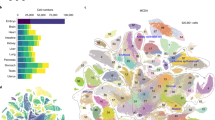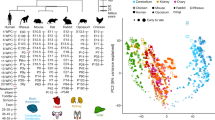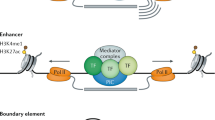Abstract
The T locus encodes a product with DNA binding activity that is likely to play a role in the development of all vertebrate organisms. We have identified and characterized a novel family of mouse genes that share a protein motif, the T–box, with the prototypical T locus. The T–box domain of the T locus co–localizes with its DNA binding activity. Each T–box gene is expressed in a unique temporal and spatial pattern during embryogenesis. Phylogenetic analysis suggests that at least three T–box genes were present in the common ancestor to vertebrates and invertebrates. Thus, members of the T–box family could have played a role in the evolution of all metazoan organisms.
This is a preview of subscription content, access via your institution
Access options
Subscribe to this journal
Receive 12 print issues and online access
$209.00 per year
only $17.42 per issue
Buy this article
- Purchase on Springer Link
- Instant access to full article PDF
Prices may be subject to local taxes which are calculated during checkout
Similar content being viewed by others
References
Dobrovolskaia-Zavadskaia, N. & Kobozieff, N. Sur la reproduction des souris anoures. C. r. Séane. Soc. Biol. 97, 116–119 (1927).
Herrmann, B.G., Labeit, S., Poustka, A., King, T.R. & Lehrach, H. Cloning of the T gene required in mesoderm formation in the mouse. Nature 343, 617–622 (1990).
Smith, J.C., Price, B.M.J., Green, J.B.A., Weigel, D. & Herrmann, B.G. Expression of a Xenopus homolog of a Brachyury (T) is an immediate-early response to mesoderm induction. Cell 67, 79–87 (1991).
Schulte-Merker, S., Ho, R.K., Herrmann, B.G. & Nüsslein-Volhard, C. The protein product of the zebrafish homologue of the mouse T gene is expressed in nuclei of the germ ring and the notochord of the early embryo. Development 116, 1021–1032 (1992).
Herrmann, B.G. Action of the Brachyury gene in mouse embryogenesis. Ciba Found. Symp. 165, 78–91 (1992).
Cunliffe, V. & Smith, J.C. Ectopic mesoderm formation in Xenopus embryos caused by widespread expression of a Brachyury homologue. Nature 358, 427–430 (1992).
Kispert, A. & Herrmann, B.G. The Brachyury gene encodes a novel DNA binding protein. EMBO J. 12, 3211–3220 (1993).
McGinnis, W. & Krumlauf, R. Homeobox genes and axial patterning. Cell 68, 283–302 (1992).
Gruss, P. & Walther, C., Pax in development. Cell 69, 719–722 (1992).
He, X. & Rosenfeld, M.G. Mechanisms of complex transcriptional regulation: Implications for brain development. Neuron 7, 183–196 (1991).
Pflugfelder, G.O., Roth, H. & Poeck, B. A homology domain shared between Drosophila optomotor-blind and mouse Brachyury is involved in DNA binding. Biochem. Biophys. res. Comm. 186, 918–925 (1992).
Pflugfelder, G.O. et al. Genetic and molecular characterization of the optomotor-blind gene locus in Drosophila melanogaster . Genetics 126, 91–104 (1990).
Pflugfelder, G.O. et al. The lethal(1) optomotor-blind gene of Drosophila melanogaster is a major organizer of optic lobe development: Isolation and characterization of the gene. Proc. natn. Acad. Sci. U.S.A. 89, 1199–1203 (1992).
Rowe, L.B. et al. Maps from two interspecific backcross DNA panels available as a community genetic mapping resource. Mammal. Genome 5, 253–274 (1994).
Silver, L.M., Nadeau, J.H. & Goodfellow, P.N. Encyclopedia of the Mouse Genome III. Mammal. Genome 4 (special issue), S1–S283 (1993).
Wilkinson, D.G., Bhatt, S. & Herrmann, B.G. Expression pattern of the mouse T gene and its role in mesoderm formation. Nature 343, 657–659 (1990).
Chomczynski, P. & Sacchi, N. Single step method of RNA isolation by acid guanidinium thiocyanate-phenol-chloroform extraction. Anal. Biochem. 161, 156–159 (1987).
Foley, K.P., Leonard, M.W. & Engel, J.D. Quantitation of RNA using the polymerase chain reaction. Trend. Genet. 9, 380–385 (1993).
Himmelbauer, H. & Silver, L.M. High-resolution comparative mapping of mouse chromosome 17. Genomics 17, 110–120 (1993).
Fahrner, K., Hogan, B.L.M. & Flavell, R.A. Transcription of H-2 and Qa genes in embryonic and adult mice. EMBO J. 6, 1265–1271 (1987).
Devereux, J., Haeberli, P. & Smithies, O. A comprehensive set of sequence analysis programs for the VAX. Nucl. Acids Res. 12, 387–395 (1984).
Swofford, D.L. Phylogenetic Analysis Using Parsimony (PAUP), version 3.0k. (Illinois Natural History Survey, Champaign, 1991).
Conlon, R.A. & Rossant, J. Exogenous retinoic acid reapdily induces anterior ectopic expression of murine Hox-2 genes in vivo. Development 116, 357–368 (1992).
Author information
Authors and Affiliations
Rights and permissions
About this article
Cite this article
Bollag, R., Siegfried, Z., Cebra-Thomas, J. et al. An ancient family of embryonically expressed mouse genes sharing a conserved protein motif with the T locus. Nat Genet 7, 383–389 (1994). https://doi.org/10.1038/ng0794-383
Received:
Accepted:
Issue Date:
DOI: https://doi.org/10.1038/ng0794-383
This article is cited by
-
Understanding paraxial mesoderm development and sclerotome specification for skeletal repair
Experimental & Molecular Medicine (2020)
-
Genetic associations of the response to inhaled corticosteroids in asthma: a systematic review
Clinical and Translational Allergy (2019)
-
The evolving role of T-bet in resistance to infection
Nature Reviews Immunology (2019)
-
Tooth agenesis and orofacial clefting: genetic brothers in arms?
Human Genetics (2016)
-
Segregating neural and mechanosensory fates in the developing ear: patterning, signaling, and transcriptional control
Cell and Tissue Research (2015)



